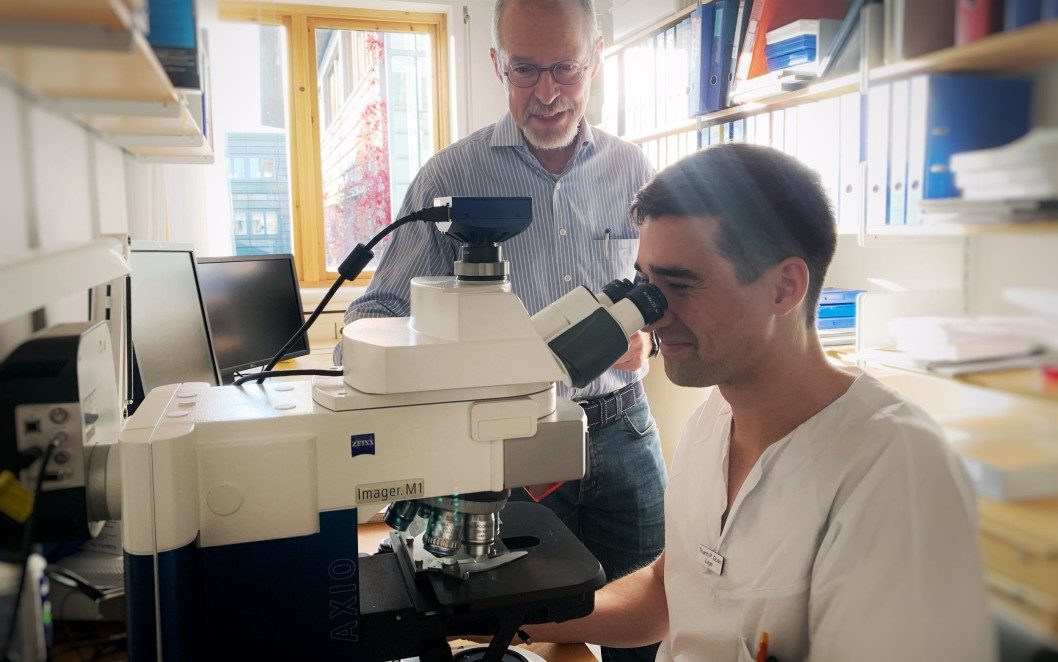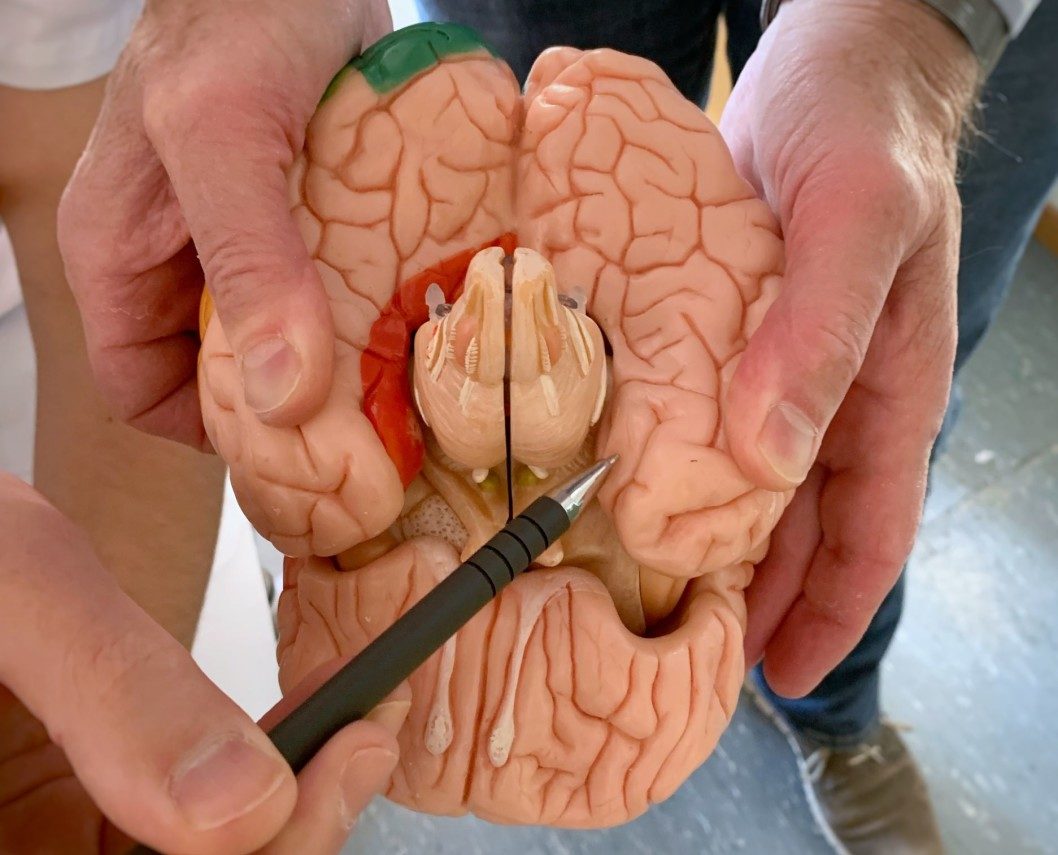
His results are wrong.
Doan is investigating the intricacies of the parts of the brain that keep track of memory, place and time. His task is to look more closely at how the signals from our senses flow into these brain parts.
A recognized model states that there are two parallel streams of information:
One stream includes visual sensory impressions that travel to the sense of place, and the second stream is of other impressions that go to the lateral entorhinal cortex - the area that integrates our sense of time with the content of our memories.
Doan dyes rat brain cells to get a picture of where the information pathways are. But the data coming out of the experiments aren't matching the model.
Instead of finding two parallel streams, Doan's results show that almost all the information whizzes directly into the lateral entorhinal cortex, the time-sense part of the brain.
It appears that the lateral entorhinal cortex is an information supercentre for everything coming in from the entire sensory system and the brain.
It's like the brain version of all roads leading to Rome.
Could the prevailing model be wrong?
He must have done something wrong.
The doctoral candidate runs the experiments again, slightly differently. But the new results are equally disappointing. Doan thinks he might not be cut out to do research. Soon, someone will probably figure out that he's completely useless!
"I was new at this and felt like a lousy researcher," Doan says.
But slowly a new thought emerges.
What if there's actually nothing wrong with the results? What if it's the acclaimed model - the one that's been the accepted truth for the last 25 years - that doesn't hold up?
Doan launches into his research with a new goal: to find data that shows - clearly enough to convince the other researchers in the group - that the old model is wrong.
He especially needs to convince his supervisor, Menno Witter. Witter is not just one of the world's leading experts in the field. He is also one of the researchers behind the prevailing model.
Encouraged to be critical
Having his model debunked "was interesting - and difficult," says Witter, head of one of the research groups at the Kavli Institute of Neuroscience.
"After all, a hypothesis becomes your child. But I've always told students that they should be critical of what I and other researchers in the field say and believe. People coming in from outside can see things in a new way."
And just this kind of fresh look is what Doan presents to Witter and the rest of the group in 2017.
It doesn't take long for Doan's data to turn his supervisor's initial scepticism into enthusiasm. An old model may fall, but that's what happens to scientific models from time to time. And the possibilities that open up are even more exciting.
Doan and Witter embark on the intense work of finding out if it's true that the model is really wrong - and that the brain has one supercentre for information instead of two parallel streams of information.
Thanks to Witter, they have exactly what they need to get to the bottom of the matter: a whole load of old samples.
Indiana Jones
Witter has kept brain samples that were prepared over 20 years ago and that are the underpinnings for the established model of how the brain parts work. The professor brought a whole container of them along when he moved to Norway from the Netherlands to start work at NTNU.
Now they open the boxes full of dusty glass plates with thin slices of rat brain inside, on the lookout for forgotten tracks.
"I felt a bit like Indiana Jones," says Doan.
He and Witter re-examine the samples, using today's methods. And then they see it: although it is understandable that the researchers came to the conclusions they did at the time, the new research shows that the old conclusion was probably a misinterpretation.
Doan and Witter also review data from several old studies conducted by other researchers, both on rodents and primates - the mammalian group that includes humans. All the new analyses point in the same direction.
The prevailing model is wrong.
It appears there aren't different parallel streams of sensory information entering the hippocampus. Instead it seems there is a central location that collects and processes almost all the incoming information.

The signs were there the whole time. The researchers behind the old studies even noted that there were some weird features of the results that didn't quite fit. Why hadn't anyone understood the connection before?
Witter believes there may be several reasons for that.
"All scientists do experiments based on a certain idea or model. This guides the study design and how we read the results," he says.
And the rapid technological developments have clearly given today's researchers much more precise and sensitive research methods, which enable previously unknown details to emerge.
These details can give us completely new insights into how the brain works. And maybe with time, it will provide vital information on what sometimes makes it not work, such as in patients with Alzheimer's disease.
The disease starts right in the "Rome" of the brain, in the cells that receive and handle a cacophony of signals from the entire sensory system and the rest of the brain.
Long before the first feeble symptoms, decades before the diagnosis, these cells begin to die.
Memory central
It's all about memories.
Researchers have long known that the hippocampus is essential for creating episodic memories, the personal and unique memories of small and large events in our everyday lives. Together, these memories allow us to see relationships, gain an overview and understand the world around us.
An episodic memory consists of three types of information: what, where and when.
But creating an impression of time, place and content from a jumble of individual signals from senses like sight and hearing is extremely complicated. Scientists have long suspected that the tiny little hippocampus can hardly be the whole story.
Place sense and time sense
Maybe a lot of this work happens before the information gets to the hippocampus?
This thought led researchers to examine sections of the brain that come earlier in the information streams, and that send signals to the hippocampus.
The studies led to the discovery of the brain's "where" knowledge, the grid cells that give us our sense of location and the ability to navigate. It was this discovery that earned Edvard and May-Britt Moser the Nobel prize in medicine in 2014.
And in 2018, Kavli researchers showed that the adjacent area - the lateral entorhinal cortex - creates our sense of time. It is, in other words, the brain's "when" knowledge.
The prevailing model thus assumed that parallel streams of information went into each of these areas, which then transmitted signals to the hippocampus.
But now it seems that the tasks of the lateral entorhinal cortex are far more extensive.
Connected to everything
Both Doan's findings and several other studies suggest that the lateral entorhinal cortex is quite special. This layer of cells is literally connected to everything.
As with cells elsewhere in the brain, these cells have lots of web-like strands that extend outward. These threads have tens of thousands of connections to other neurons and can receive signals from them.
But there the similarity ends. In most places, cells are selectively attached to cells from two or three other regions in the brain. However, the cells in the lateral entorhinal cortex have links to many more places, including the brain region that creates our sense of place.
Information central
"These cells take in an absolutely insane amount of different information," says Doan.
The lateral entorhinal cortex appears to be the brain's information centre. It is probably the place that takes all kinds of information and puts it together into something that makes sense. Then it sends it on to the hippocampus.
"This is the first indication we have that the lateral entorhinal cortex plays such a critical role in the system for making complex memories," says Witter.
Solid study
Professor Marianne Fyhn at the University of Oslo is also researching the brain but did not participate in Doan's study. She finds his study both solid and thorough.
"The findings clearly challenge the existing model for how information enters the memory structure of the hippocampus," she writes in an email to forskning.no.
She believes the results will inspire researchers to carry out more studies to find out how the lateral entorhinal cortex actually works to build meaning based on the tremendous flow of dissimilar information.
"I can hardly wait to test this out myself or follow others who are now taking detailed measurements to examine it," Fyhn writes.
She also finds it exciting that the study shows that what happens in rat brains is very similar to what happens in human brains.
This means that further studies on rats can give us more knowledge about how our own brain works and what goes wrong when we get sick, as in people who get Alzheimer's.
Witter himself believes that the discovery of the special role of the lateral entorhinal cortex is highly relevant to further the research on this disorder.
"It fits perfectly with what we know about Alzheimer's disease," he says.
Extremely strong link to Alzheimer's
Many studies have shown that Alzheimer's is closely related to the cells of the lateral entorhinal cortex. The earliest sign of the disease is that these cells begin to fade away.
"The connection is extremely strong," says Witter.
Researchers have investigated patients who go to the doctor with mild memory disorders. All the patients who had changes in their lateral entorhinal cortex later developed Alzheimer's. Most other patients did not.
Now we know more about these cells. The new knowledge - that the cells here constitute the brain's information centre - matches the symptoms of Alzheimer's patients.
If the information centre gradually stops collecting, interpreting and communicating the sensory impressions, it becomes impossible for the hippocampus to form new episodic memories and understand the surroundings.
Not bitter
Witter and Doan hope the discovery will eventually help us understand what is causing these vital cells to die.
"I think there's something special about these cells that makes them vulnerable, says Witter.
"They're big cells that require a lot of energy. One hypothesis is that they lose the ability to generate enough energy."
Another issue is that large cells generate a lot of waste products. Maybe the cleaning system to remove these substances fails to work properly.
"We also know that these cells make very special molecules that are probably involved in the mechanism that drives Alzheimer's."
The path from basic research to new treatments for Alzheimer's is long. But the better models we have of the brain, the better chance we have of figuring out how to prevent these important cells from failing.
It can't be helped that some renowned scientists probably have to let go of their longstanding hypotheses.
Witter is not bitter. On the contrary. This is how science should ideally work.
"Models attempt to provide a correct understanding of reality based on the data we have. Sometimes they need to be replaced. A lot of us in the field have agreed that the model we had probably was too simple.
"The feeling I have now is that I'm happy and ready to accept that."
Reference:
T. P. Doan, M.J.D. Lagartos, E. S. Nilssen, S. Ohara, M. P. Witter. Convergent projections from perirhinal and postrhinal cortices suggest a multisensory nature of lateral, but not medial, entorhinal cortex, Cell Reports, October 2019



Reader Comments